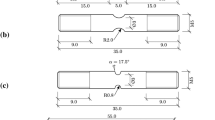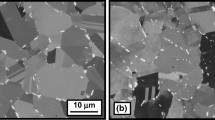Abstract
Dynamic tensile experimental techniques of high-strength alloys using a Kolsky tension bar implemented with pulse shaping and advanced analytical and diagnostic techniques have been developed. The issues that include minimizing abnormal stress peak, determining strain in specimen gage section, evaluating uniform deformation, as well as developing pulse shaping for constant strain rate and stress equilibrium have been addressed in this study to ensure valid experimental conditions and obtainment of reliable high-rate tensile stress–strain response of alloys with a Kolsky tension bar. The techniques were applied to characterize the tensile stress–strain response of a 4330-V steel at two high strain rates. Comparing these high-rate results with quasi-static data, the strain rate effect on the tensile stress–strain response of the 4330-V steel was determined. The 4330-V steel exhibits slight work-hardening behavior in tension and the tensile flow stress is significantly sensitive to strain rate.














Similar content being viewed by others
References
Kolsky H (1949) An investigation of the mechanical properties of materials at very high rates of loading. Proc Phys Soc Lond B62:676–700
Chen W, Song B (2011) Split Hopkinson (Kolsky) Bar: Design, Testing and Applications. Springer, New York
Harding J, Wood EO, Campbell JD (1960) Tensile testing of materials at impact rates of strain. J Mech Eng Sci 2:88–96
Hauser FE (1966) Techniques for measuring stress–strain relations at high strain rates. Exp Mech 6:395–402
Lindholm US, Yeakley LM (1968) High strain rate testing: tension and compression. Exp Mech 8:1–9
Kawata K, Hashimoto S, Kurokawa K, Kanayama N (1979) A New Testing Method for the Characterization of Materials in High-Velocity Tension. In: Harding J (ed) Mechanical Properties at High Rates of Strain, Inst. Phys. Conf. Ser. 47:71–80, Oxford
Nicholas T (1981) Tensile testing of materials at high rates of strain. Exp Mech 21:177–188
Staab GH, Gilat A (1991) A direct-tension split Hopkinson Bar for high strain-rate testing. Exp Mech 31:232–235
Nemat-Nasser S (2000) Introduction to High Strain Rate Testing, vol 8, ASM handbook. Mechanical Testing and Evaluation, Materials Park, pp 427–446
Nemat-Nasser S, Isaacs JB, Starrett JE (1991) Hopkinson techniques for dynamic recovery experiments. Proc Roy Soc London 435:371–391
Brown EN, Rae PJ, Gray GT (2006) The influence of temperature and strain rate on the tensile and compression constitutive response of four fluoropolymers. J Phys IV 134:935–940
Rajendran AM, Bless SJ (1986) Determination of tensile flow stress beyond necking at very high strain rate. Exp Mech 26:319–323
Børvik T, Hopperstad OS, Dey S, Pizzinato EV, Langseth M, Albertini C (2005) Strength and ductility of weldox 460 E steel at high strain rates, elevated temperatures and various stress triaxialities. Eng Fract Mech 72:1071–1087
Arthington MR, Siviour CR, Petrinic N (2012) Improved materials characterisation through the application of geometry reconstruction to quasi-static and high-strain-rate tension tests. Int J Impact Eng 46:86–96
Curtze S, Kuokkala V-T, Hokka M, Peura P (2009) Deformation behavior of TRIP and DP steels in tension at different temperatures over a wide range of strain rates. Mater Sci Eng A507:124–131
Gilat A, Schmidt TE, Walker AL (2009) Full field strain measurement in compression and tensile split Hopkinson Bar experiments. Exp Mech 49:291–302
Rusinek A, Klepaczko JR (2003) Impact tension of sheet metals – effect of initial specimen length. J Phys IV France 110:329–334
Kuroda M, Uenishi A, Yoshida H, Igarashi A (2006) Ductility of interstitial-free steel under high strain rate tension: experiments and macroscopic modeling with a physically-based consideration. Int J Solids Struct 43:4465–4483
Lee D, Tippur HV, Jensen BJ, Bogert PB (2011) Tensile and fracture characterization of PETI-5 and IM7/PETI-5 grphite/epoxy composites under quasi-static and dynamic loading conditions. Trans ASME J Eng Mater Tech 133:021015, 11 pp
Nie X, Song B, Ge Y, Chen W, Weerasooriya T (2009) A split Hopkinson tension bar for extra-soft specimens. Exp Mech 49:451–458
Frew DJ, Forrestal MJ, Chen W (2005) Pulse shaping techniques for testing elastic–plastic materials with a split Hopkinson pressure Bar. Exp Mech 45:186–195
Song B, Antoun BR, Connelly K, Korellis J, Lu W-Y (2011) Improved Kolsky tension bar for high-rate tensile characterization of materials. Meas Sci Technol 22:045704
Rusinek A, Zaera R, Klepaczko JR, Cheriguene R (2005) Analysis of inertia and scale effects on dynamic neck formation during tension of sheet steel. Acta Mater 53:5387–5400
Song B, Antoun BR (2012) Pseudo stress response in kolsky tension bar experiments. Exp Mech 52:525–528
Ravichandran G, Subhash G (1994) Critical appraisal of limiting strain rates for compression testing of ceramics in a split Hopkinson Pressure Bar. J Am Ceram Soc 77:263–267
Tarigopula V, Hopperstad OS, Langseth M, Clausen AH, Hild F (2008) A study of localisation in dual-phase high-strength steels under dynamic loading using digital image correlation and FE analysis. Int J Solids Struct 45:601–619
Li Y, Ramesh KT (2007) An optical technique for measurement of material properties in the tension Kolsky bar. Int J Impact Eng 34:784–798
Song B, Forrestal MJ, Chen W (2006) Dynamic and quasi-static propagation of compaction waves in a Low-density epoxy foam. Exp Mech 46:127–136
Acknowledgments
The authors would like to thank Dr. Wei-Yang Lu for the valuable discussion about this work. Sandia National Laboratories is a multi-program laboratory managed and operated by Sandia Corporation, a wholly owned subsidiary of Lockheed Martin Corporation, for the U.S. Department of Energy’s National Nuclear Security Administration under contract DE-AC04-94AL85000.
Author information
Authors and Affiliations
Corresponding author
Rights and permissions
About this article
Cite this article
Song, B., Antoun, B.R. & Jin, H. Dynamic Tensile Characterization of a 4330-V Steel with Kolsky Bar Techniques. Exp Mech 53, 1519–1529 (2013). https://doi.org/10.1007/s11340-013-9721-x
Received:
Accepted:
Published:
Issue Date:
DOI: https://doi.org/10.1007/s11340-013-9721-x




